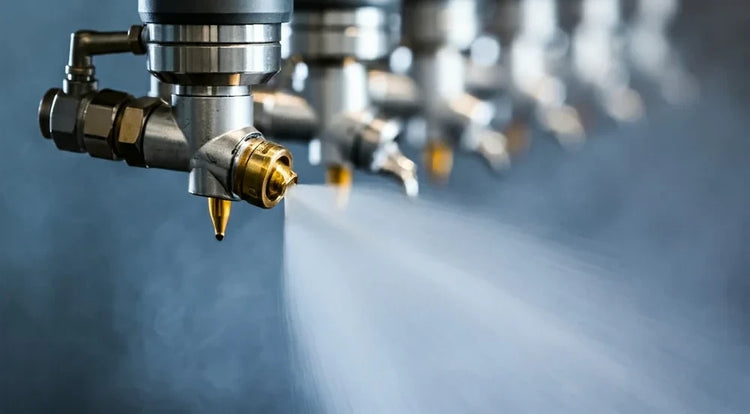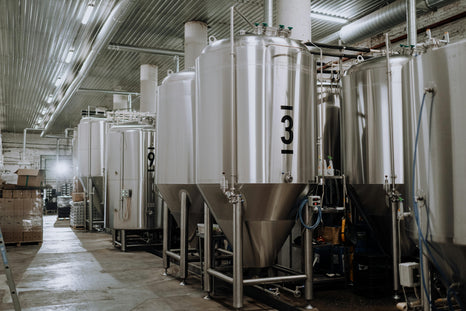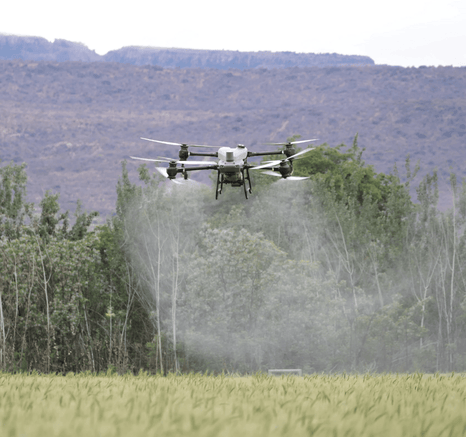Hydraulic atomizing nozzles are a big deal in the world of spraying tech. They're used in everything from farming to industrial cleaning. These nozzles break down liquids into tiny droplets, which makes spraying more efficient and effective. As technology advances, the design and function of these nozzles have also evolved, making them more efficient and versatile for different applications. In this article, we'll dig into how these nozzles work, what makes them tick, and the impact they have on various industries.
Key Takeaways
- Hydraulic atomizing nozzles are key in transforming liquids into fine sprays for diverse applications.
- The design and material of a nozzle significantly affect its performance and durability.
- Advancements in nozzle technology have improved efficiency and reduced environmental impact.
- Pressure and flow rate are crucial factors influencing nozzle efficiency.
- Customization of nozzles can optimize performance for specific industry needs.
The Role of Hydraulic Atomizing Nozzles in Modern Spraying Applications
Understanding Hydraulic Atomization
Hydraulic atomization is a fascinating process where liquid is transformed into a fine spray through the application of pressure. This method is integral to numerous industries, enabling efficient and precise application of liquids ranging from water to chemicals. The magic lies in how these nozzles use pressure to break down liquid into tiny droplets, ensuring even coverage and minimal waste. This process not only enhances efficiency but also contributes to the effectiveness of various spraying applications.
Key Features of Hydraulic Atomizing Nozzles
Hydraulic atomizing nozzles boast several key features that make them indispensable in modern spraying systems:
- Precision: They offer high precision in droplet size and distribution, which is crucial for applications requiring uniform coverage.
- Versatility: These nozzles can handle a wide range of liquid viscosities, making them suitable for diverse applications.
- Efficiency: By minimizing liquid waste, they enhance the overall efficiency of spraying operations.
Applications in Various Industries
Hydraulic atomizing nozzles find applications across a myriad of industries due to their efficiency and versatility:
- Agriculture: Used in crop spraying to ensure even distribution of pesticides and fertilizers.
- Manufacturing: Integral in processes like cooling, coating, and lubricating.
- Environmental Management: Employed in dust suppression and odor control systems.
The adaptability of hydraulic atomizing nozzles makes them a staple in both traditional and cutting-edge industries, underscoring their role in advancing modern spraying applications.
Design and Functionality of Hydraulic Atomizing Nozzles
Internal Structure and Mechanism
Hydraulic atomizing nozzles are like the unsung heroes in spraying systems. Their design is all about converting liquid into a fine mist. Inside, these nozzles have a pretty straightforward setup. They rely on high pressure to push liquid through a tiny orifice, creating a spray. The internal structure often includes a swirl chamber that helps in breaking up the liquid into droplets. This swirling action is crucial because it ensures the droplets are uniform in size, which is key for effective spraying.
Impact of Design on Atomization Efficiency
The design of these nozzles directly impacts how well they perform. A well-designed nozzle will produce a consistent spray pattern and droplet size, which is essential for applications like agriculture or painting. Here are some design factors that influence efficiency:
- Orifice Size: Smaller orifices create finer sprays but may clog easily.
- Swirl Chamber Design: Enhances the breakup of liquid, affecting droplet size.
- Material Used: Durable materials resist wear and tear, maintaining performance over time.
Comparative Analysis with Other Nozzle Types
When you compare hydraulic atomizing nozzles with other types, like air-assisted or rotary nozzles, each has its perks. Hydraulic nozzles are simple and efficient, ideal for low-viscosity fluids. Here's a quick comparison:
|
Nozzle Type |
Best for |
Complexity |
Efficiency |
|
Hydraulic |
Low-viscosity fluids |
Low |
High |
|
Air-assisted |
High-viscosity fluids |
Medium |
Medium |
|
Rotary |
Large-scale applications |
High |
High |
Understanding the design and functionality of hydraulic atomizing nozzles can help in selecting the right type for specific needs, balancing efficiency with operational requirements.
Factors Influencing the Efficiency of Hydraulic Atomizing Nozzles
Pressure and Flow Rate Considerations
The efficiency of hydraulic atomizing nozzles heavily depends on the pressure and flow rate of the liquid being sprayed. Higher pressures typically result in finer atomization, which can enhance the coverage area and improve the effectiveness of the spray. However, there is a balance to be struck; too high a pressure can lead to increased wear on the nozzle and potentially reduce its lifespan.
- Pressure Levels: Different applications require different pressure levels. For instance, agricultural spraying might need lower pressures compared to industrial applications.
- Flow Rate: This determines how much liquid can be sprayed over a given time. A higher flow rate can be beneficial for large area coverage but may not be suitable for applications needing precision.
- Droplet Size and Velocity: These factors are directly influenced by pressure and flow rate, impacting the distribution and effectiveness of the spray.
Material and Durability Aspects
The materials used in constructing hydraulic atomizing nozzles play a significant role in their efficiency and longevity. Nozzles made from durable materials like stainless steel or high-quality plastics can withstand higher pressures and are resistant to corrosion and wear.
- Material Selection: Choosing the right material is crucial for ensuring the nozzle can handle the intended application's demands.
- Corrosion Resistance: Especially important in applications involving chemicals or corrosive substances.
- Longevity: Materials that resist wear and tear contribute to longer-lasting nozzles, reducing the frequency of replacements and maintenance.
Influence of Nozzle Geometry
The geometric design of a nozzle significantly affects its atomization efficiency. The internal structure, including the shape and size of the nozzle opening, determines how the liquid is broken into droplets.
- Nozzle Shape: Different shapes can produce varying spray patterns, which might be more or less suitable depending on the application.
- Spray Pattern: The desired outcome, whether it's a fine mist or a concentrated jet, will dictate the appropriate nozzle geometry.
- Internal Design: Features like swirl chambers or specially designed orifices can enhance atomization by promoting better liquid distribution and droplet formation.
Understanding the interplay between these factors is essential for optimizing the performance of hydraulic atomizing nozzles in any given application. Adjustments in pressure, material choice, and nozzle design can lead to significant improvements in efficiency and effectiveness.
Advancements in Hydraulic Atomizing Nozzle Technology
Innovations in Nozzle Design
Hydraulic atomizing nozzles have seen significant innovations in recent years. These advancements focus on improving droplet size control and enhancing spray patterns to meet diverse application needs. One of the most notable improvements is the development of nozzles that can produce ultra-fine sprays, which are essential in industries like agriculture and pharmaceuticals. These nozzles often utilize advanced materials and precision engineering to achieve consistent performance.
Integration with Modern Spraying Systems
The integration of hydraulic atomizing nozzles with modern spraying systems has also evolved. Today’s systems can adjust nozzle pressure and flow rate in real-time, allowing for precise control over spray characteristics. This adaptability is crucial for applications requiring specific droplet sizes or spray patterns. Additionally, smart technologies are being incorporated, enabling remote monitoring and adjustments, thus enhancing operational efficiency and reducing manual interventions.
Future Trends and Developments
Looking ahead, the future of hydraulic atomizing nozzles appears promising with several trends on the horizon:
- Smart Nozzles: With the rise of IoT, nozzles are becoming smarter, offering features like automatic adjustments based on environmental conditions.
- Sustainable Materials: There is a growing trend towards using eco-friendly materials in nozzle production to reduce environmental impact.
- Enhanced Durability: Future designs focus on increasing the lifespan of nozzles, reducing the need for frequent replacements and maintenance.
As technology advances, hydraulic atomizing nozzles are set to become more efficient, adaptable, and environmentally friendly, meeting the ever-evolving demands of modern industries.
Evaluating the Performance of Hydraulic Atomizing Nozzles
Methods for Measuring Atomization Efficiency
To get a grip on how well hydraulic atomizing nozzles work, it's all about the metrics. The two big ones are droplet size and distribution. Smaller droplets generally mean better coverage and efficiency. So, measuring these accurately is crucial. Tools like laser diffraction and high-speed cameras are often used. They help in capturing the droplet size and speed, which are key to understanding nozzle performance.
Here's a quick list of methods:
- Laser Diffraction: Captures particle size distribution by analyzing light patterns.
- High-Speed Imaging: Provides detailed visuals of droplet formation and dispersion.
- Phase Doppler Anemometry: Measures droplet velocity and size simultaneously.
Case Studies and Experimental Results
Looking at real-world examples gives us a clearer picture. Various studies have shown that the design of the nozzle can significantly impact performance. For instance, nozzles with a rotating core often have a wider spray angle, which can be beneficial in certain applications.
- Rotating Core Nozzles: Typically offer a larger spray angle, enhancing coverage.
- Hollow Cone Nozzles: Known for producing finer droplets, suitable for precise applications.
- Solid Cone Nozzles: Deliver a more concentrated spray, often used where targeted application is needed.
Challenges in Performance Assessment
Assessing the performance isn't without its hurdles. One major challenge is dealing with varying environmental conditions, which can affect spray patterns. Additionally, the consistency of the liquid being sprayed can also play a role. Sometimes, nozzles clog or wear out, skewing results.
Performance evaluation of hydraulic atomizing nozzles is complex due to the interplay of multiple factors such as nozzle design, liquid properties, and environmental conditions. Understanding these variables is key to optimizing their use in various applications.
To sum it up, evaluating these nozzles is about understanding their efficiency in real-world conditions, taking into account all the variables that can affect their performance.
Environmental and Economic Impacts of Hydraulic Atomizing Nozzles
Energy Consumption and Efficiency
Hydraulic atomizing nozzles are known for their energy efficiency. These nozzles rely on high-pressure liquid flow to achieve atomization, which means they can operate effectively at lower energy levels compared to other types of nozzles, like air atomizing nozzles. This energy efficiency translates into reduced operational costs and lower environmental impact, making them an attractive choice for industries seeking sustainable solutions. Additionally, the efficient atomization process ensures minimal waste, further enhancing their eco-friendly profile.
Environmental Benefits and Concerns
The use of hydraulic atomizing nozzles in spraying applications can significantly reduce environmental pollution. By producing finer droplets, these nozzles ensure more precise application of liquids, which minimizes runoff and reduces the risk of contaminating surrounding areas. However, there are concerns regarding the potential for nozzle clogging, which can lead to uneven distribution and increased waste. Proper maintenance and selection of suitable materials can mitigate these issues, ensuring consistent performance and environmental safety.
Cost-Effectiveness in Industrial Applications
From an economic perspective, hydraulic atomizing nozzles offer substantial cost savings. Their design allows for efficient use of liquids, reducing the amount of chemicals needed for various industrial applications. This not only cuts down on material costs but also lowers the expenses associated with waste disposal and environmental compliance. Moreover, the durability of these nozzles means less frequent replacements and repairs, further contributing to cost savings. In industries where precision and efficiency are paramount, the initial investment in high-quality hydraulic atomizing nozzles can lead to significant long-term financial benefits.
In summary, hydraulic atomizing nozzles present a compelling case for both environmental and economic advantages. Their ability to deliver precise, efficient spraying while minimizing waste and energy use positions them as a key component in modern, sustainable industrial practices.
Optimizing Hydraulic Atomizing Nozzles for Specific Applications
Customization for Industry Needs
When it comes to hydraulic atomizing nozzles, one size definitely doesn’t fit all. Different industries have unique requirements, and customizing these nozzles can make a big difference. For example, agriculture might need nozzles that produce fine mist for even crop coverage, while the automotive industry could require a more focused spray for precision painting. Customization can involve adjusting the nozzle’s spray angle, flow rate, or even the material it’s made from to suit specific needs.
- Spray Angle Adjustments: Altering the spray angle can help in achieving the right coverage for different applications.
- Flow Rate Modifications: Tuning the flow rate ensures that the right amount of liquid is delivered, which is crucial for efficiency.
- Material Selection: Choosing the right material for the nozzle can enhance its durability and resistance to specific chemicals.
Balancing Performance and Cost
Finding the sweet spot between performance and cost is a balancing act. While high-performance nozzles might offer superior atomization, they can be expensive. On the other hand, cheaper options might not deliver the desired results. It's about weighing the pros and cons. Sometimes, investing in a more expensive nozzle can save money in the long run by reducing waste and improving efficiency.
- Evaluate Needs: Understand the specific requirements of your application to avoid over-spending on unnecessary features.
- Cost-Benefit Analysis: Consider the long-term savings against the initial investment.
- Quality vs. Price: Sometimes, a slightly higher upfront cost can lead to better performance and less frequent replacements.
Strategies for Maintenance and Longevity
Taking care of your nozzles is key to keeping them working efficiently. Regular maintenance can prevent clogs and wear, which can affect performance. Inspecting nozzles for wear and tear, cleaning them regularly, and replacing worn parts can extend their life significantly.
- Routine Inspections: Regular checks can help identify issues before they become major problems.
- Cleaning Protocols: Implementing a cleaning schedule can prevent build-up and clogs.
- Replace Worn Parts: Timely replacement of parts can prevent larger failures and maintain efficiency.
Properly maintained nozzles not only perform better but also last longer, offering more value over time. It's about keeping things running smoothly and efficiently, reducing downtime, and ensuring consistent performance.
When it comes to making the best use of hydraulic atomizing nozzles, understanding their specific applications is key. At NozzlePro, we are dedicated to helping you find the right nozzle for your needs. Whether you're in automotive, food and beverage, or any other industry, we have the expertise to guide you. Explore our website today to explore our wide range of nozzles and get the support you need!
Conclusion
In wrapping up our exploration of hydraulic atomizing nozzles, it's clear these devices are pivotal in modern spraying applications. They offer a blend of precision and efficiency, making them indispensable in various industries. Whether it's agriculture, manufacturing, or environmental management, the ability of these nozzles to produce fine, consistent droplets is unmatched. This not only enhances the effectiveness of spraying but also optimizes resource use, reducing waste and improving outcomes. As technology advances, we can expect even more innovative designs that push the boundaries of what's possible with hydraulic atomizing nozzles. Their role in improving operational efficiency and environmental sustainability cannot be overstated, marking them as a key component in the future of spraying technology.












